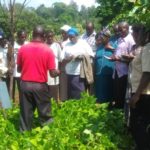Low agricultural yield is one of the many factors that have hindered Africa from reaching its full agriculture potential. Despite its vast arable land – about 60% of the world’s uncultivated arable land is in Africa. Staple crop yields in Africa, for example, have barely grown in the last 25 years, and remain the lowest of any region in the world at just 56% of the global average.
Increasing agricultural production and productivity is the foundation for any transformation of agriculture on the continent.
It is envisioned that investing in the High Iron Bean (HIB) Value will enhance business opportunities and investments, and provide Income generating avenues for women and youth.
The HIB value chain will also greatly enhance nutrition and food security among target households.
The low high iron bean (HIB) production in Kenya can be attributed to several factors:
Low adoption of improved HIB varieties
In Kenya, smallholder farmers continue to experience low HIB productivity owing to the failure to target the right HIB varieties to the right agro-ecological zones coupled with poor agronomic practices.
Part of this challenge lies in the levels of awareness of the available varieties resulting in low adoption of the right HIB varieties. This challenge is compounded by poor agronomic practices among smallholder farmers.
Limited access to extension services
While the extension officer to farmer ratio in developed countries is estimated at 1:200, the same cannot be said of developing countries like Kenya. The farmer to extension officer ratio is estimated at around 1:3000. This is even made more difficult by the limited government funding in the provision of extension services. As such, smallholder farmers cannot access quality extension services resulting in poor agricultural yields.
Limited access to assured markets
The availability of an assured market is key to improving the levels of production and productivity among smallholder farmers. A part of the reason for the slow uptake of HIB varieties is the lack of a ready off-taker.
Less focus on the nutritional value of HIB
Over the years, the focus has been on improving food security with less emphasis on nutritional security. This has resulted in the low adoption of improved HIB varieties.
The broad objectives of this HIB project will be
- To increase the HIB production area and productivity;
- To enhance business opportunities and investments within the HIB value chain;
- To improve income generation among youth and women;
- To enhance nutrition and food security among target households.
CGA Interventions
To improve HIB adoption productivity, CGA has partnered with the International Center for Tropical Agriculture (CIAT) to implement several activities.
These activities will be aimed at promoting nutrition and food security among smallholder farmers as well as to boost their farm earnings.
To help boost the farmers’ production capacities, CGA will create farmer awareness in HIB and identify and profile targeted farmer groups in the selected counties. Farmer data will be captured during planned field day activities. CIAT will train CGA extension staff on varieties’ profiles and Good Agricultural Practices (GAP) who will in return pass the acquired skills to farmers within the project.
CGA will coordinate the establishment and management of the demo plots through the lead farmer model. This will be to showcase the best agricultural practices for different HIB varieties. CGA will also organize field days in collaboration with different service providers to present the learnings from the demonstration sites to the target farmers.
Project activities will take place in 10 counties of Bungoma, Kakamega, Homa Bay, Migori, Nyamira, Narok, Bomet, Nandi, Trans Nzoia and Uasin Gishu.
CGA aims to reach an estimated 4000 smallholder farmers under the short-term phase of the partnership.

